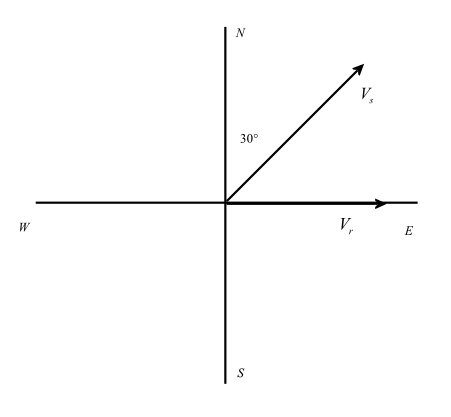
Ram moves in east direction at a speed of $6\;m/s$ and Shyam moves $30^\circ $ east of north at a speed of $6\;m/s$. The magnitude of their relative velocity is
(A) $3\;m/s$
(B) $6\;m/s$
(C) $6\sqrt 3 \;m/s$
(D) $6\sqrt 2 \;m/s$
Answer
219k+ views
Hint: In this question the concept of relative velocity is applied. Relative velocity is defined between two objects in motion. If the two objects are moving in opposite directions the relative velocity is obtained by adding the both velocities and if the two objects are moving in the same direction then the relative velocity is calculated by subtracting the velocity of one object from the other.
Complete step by step answer:
Let us consider the figure below shows the velocity and relative velocity.

Figure-(1)
In above figure the component of velocity of Shyam is shown in vertical as well as horizontal direction.
Velocity of Shyam is at an angle so the component will be taken.
The velocity of Shyam can be expressed as,
${V_s} = 6\sin 30^\circ i + 6\cos 30^\circ j$
Now we will simplify above expression.
$ \Rightarrow {V_s} = 6\left( {\dfrac{1}{2}} \right)i + 6\left( {\dfrac{{\sqrt 3 }}{2}} \right)j$
Further solve, we will get,
$ \Rightarrow {V_s} = 3i + 3\sqrt 3 j$
As we know that the relative velocity can be written as,
${V_{rs}} = {V_r} - {V_s}$
Here, ${v_{rs}}$ is the relative velocity of Ram with respect to Shyam.
Now we will substitute the values in the above equation.
$ \Rightarrow {V_{rs}} = 6i - 3i - 3\sqrt 3 j$
Further solve, we will get,
$ \Rightarrow {V_{rs}} = 3i - 3\sqrt 3 j$
Now we will calculate the magnitude of relative velocity,
$ \Rightarrow \left| {{V_{rs}}} \right| = \sqrt {{3^2} + {{\left( {3\sqrt 3 } \right)}^2}} $
Further simplify the calculation and we get,
$\therefore \left| {{V_{rs}}} \right| = 6\;m/s$
Therefore, the correct option is B.
Note: In this question the relative velocity will be calculated by breaking the velocity of Shyam in two components that are horizontal and vertical. Vector calculation is to be used instead of simple arithmetic operations. The sign of components of velocity should be used properly otherwise it will alter the final result.
Complete step by step answer:
Let us consider the figure below shows the velocity and relative velocity.

Figure-(1)
In above figure the component of velocity of Shyam is shown in vertical as well as horizontal direction.
Velocity of Shyam is at an angle so the component will be taken.
The velocity of Shyam can be expressed as,
${V_s} = 6\sin 30^\circ i + 6\cos 30^\circ j$
Now we will simplify above expression.
$ \Rightarrow {V_s} = 6\left( {\dfrac{1}{2}} \right)i + 6\left( {\dfrac{{\sqrt 3 }}{2}} \right)j$
Further solve, we will get,
$ \Rightarrow {V_s} = 3i + 3\sqrt 3 j$
As we know that the relative velocity can be written as,
${V_{rs}} = {V_r} - {V_s}$
Here, ${v_{rs}}$ is the relative velocity of Ram with respect to Shyam.
Now we will substitute the values in the above equation.
$ \Rightarrow {V_{rs}} = 6i - 3i - 3\sqrt 3 j$
Further solve, we will get,
$ \Rightarrow {V_{rs}} = 3i - 3\sqrt 3 j$
Now we will calculate the magnitude of relative velocity,
$ \Rightarrow \left| {{V_{rs}}} \right| = \sqrt {{3^2} + {{\left( {3\sqrt 3 } \right)}^2}} $
Further simplify the calculation and we get,
$\therefore \left| {{V_{rs}}} \right| = 6\;m/s$
Therefore, the correct option is B.
Note: In this question the relative velocity will be calculated by breaking the velocity of Shyam in two components that are horizontal and vertical. Vector calculation is to be used instead of simple arithmetic operations. The sign of components of velocity should be used properly otherwise it will alter the final result.
Recently Updated Pages
Two discs which are rotating about their respective class 11 physics JEE_Main

A ladder rests against a frictionless vertical wall class 11 physics JEE_Main

Two simple pendulums of lengths 1 m and 16 m respectively class 11 physics JEE_Main

The slopes of isothermal and adiabatic curves are related class 11 physics JEE_Main

A trolly falling freely on an inclined plane as shown class 11 physics JEE_Main

The masses M1 and M2M2 M1 are released from rest Using class 11 physics JEE_Main

Trending doubts
JEE Main 2026: Application Form Open, Exam Dates, Syllabus, Eligibility & Question Papers

Understanding Uniform Acceleration in Physics

Derivation of Equation of Trajectory Explained for Students

Hybridisation in Chemistry – Concept, Types & Applications

Understanding the Angle of Deviation in a Prism

Understanding Collisions: Types and Examples for Students

Other Pages
JEE Advanced Marks vs Ranks 2025: Understanding Category-wise Qualifying Marks and Previous Year Cut-offs

Units And Measurements Class 11 Physics Chapter 1 CBSE Notes - 2025-26

NCERT Solutions For Class 11 Physics Chapter 8 Mechanical Properties Of Solids

Motion in a Straight Line Class 11 Physics Chapter 2 CBSE Notes - 2025-26

NCERT Solutions for Class 11 Physics Chapter 7 Gravitation 2025-26

Understanding Atomic Structure for Beginners




